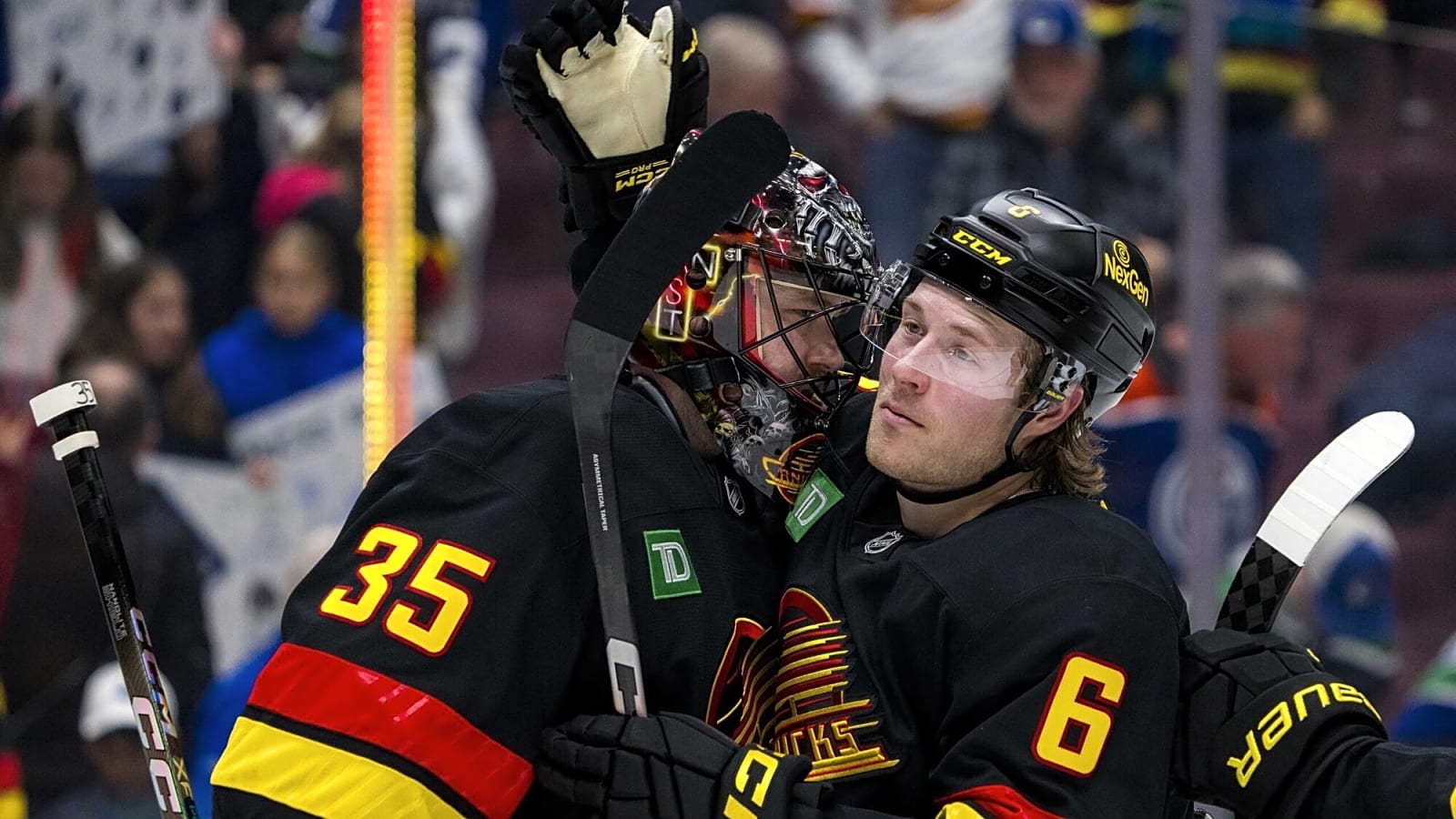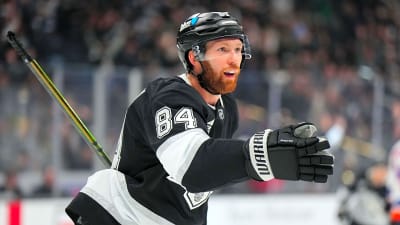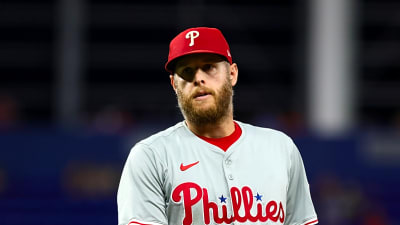
The Free Agent Frenzy of July 1 can be an overwhelming one. Teams are besieged by new arrivals, with each of them typically sporting a new bloated contract with whatever salary it took to lure them away from their old team.
It can take a while for the implications to shake out, and for teams and their fan bases to understand how they really made out with the incoming arrivals.
It’s a little easier for the Vancouver Canucks on this 2025 edition of July 1, however. That’s because, while the Canucks did sign three big contracts this year, they did so with three players they were already intimately familiar with.
Brock Boeser hit the free agent market for about five seconds and then re-signed in Vancouver for seven years at a $7.25 million AAV. A year out from their own UFA statuses, Thatcher Demko and Conor Garland also re-upped, for three years at $8.5 million and six years at $6 million, respectively.
The wisdom, short- and long-term, of these signings will remain to be determined. However, being so familiar with the trio already, we have a solid basis for comparison to conduct early analysis on their new contracts, namely their old contracts.
Below, you’ll find some straight-up comparisons between each of Boeser, Demko, and Garland’s previous contracts and the ones they just signed. It’s not the be-all and end-all of contractual analysis, but it is a decent starting point.
Brock Boeser
| Contract | Term | AAV | Age Range | Cap % At Start |
| ‘22/23 – ‘24/25 | 3 years | $6.65 million | 25-28 | 8.06% |
| ‘25/26 – ‘31/32 | 7 years | $7.25 million | 28-35 | 7.59% |
| Difference | – | +$0.6 million | – | -0.47% |
Boeser’s big payday was a…pay-cut?!
Technically, depending on how you look at it. Boeser will technically earn $600,000 a year more – and more than $30,000,000 total dollars – on this contract than his last one. But that last contract was signed in the midst of the flat cap era, and this new one has been signed after the first year of an expanded cap ceiling.
As a result, Boeser’s new deal will occupy a smaller chunk of the total team cap than did his previous deal.
That being said, the previous deal covered Boeser from ages 25 to 28, which are typically recognized as the peak years for a scoring forward. This new contract is covering 28 to 35. Are there still some prime years in there? The Canucks will certainly hope so. However, a drop-off in performance is almost inevitable at some point over the next seven years.
Another hope of the Canucks is that the cap will continue to rise even after 2027/28, and that as Boeser ages, his relative percentage of the cap continues to decrease.
In any case, for the next couple of years, Boeser has signed for an effective pay decrease. So long as he continues to play at the same general pace of the last couple of seasons, the first years of this contract should return positive value.
Thatcher Demko
| Contract | Term | AAV | Age Range | Cap % At Start |
| ‘21/22 – ‘25/26 | 5 years | $5 million | 25-30 | 6.13% |
| ‘25/26-‘28/29 | 3 years | $8.5 million | 30-33 | 8.17% |
| Difference | – | +$3.5 million | – | +2.04% |
Demko is the only one of this trio to have earned a true pay increase, anyway you slice it.
His average salary is increasing from $5 million to $8.5 million. It’s jumping up so much, in fact, that Demko will earn as much in the three years of this new contract ($25.5 million) as he did/will in the entire five-year term of the previous one ($25 million).
Unlike Boeser, Demko will also see a rise in his cap percentage, which will increase from the current 6.13% to 8.17% as of 2026/27.
But a lot has happened since Demko signed that old deal back in 2021. A Vezina Trophy nomination, for one. That alone should give Demko more bargaining power, and it apparently has.
Although injuries have also occurred. Back in 2021, Demko had suffered a couple of concussions and some minor lower-body issues. After the signing, however, they really started to pile up: a season-ending LBI in 2022, 35 games to a groin injury in 2023, 14 games to a knee injury in 2024, and then 12 playoff games on the same reinjured knee.
Then came the saga of 2024/25, with its unhealable popliteus reveal and further injuries that kept Demko out of a total of 44 games.
Is Demko a better goaltender now than he was back in 2021? That seems to be true. But is he a more reliable goaltender? That seems entirely dependent on his health.
Demko’s last deal, of five years at $5 million, proved to be one of the best-value goalie contracts in the last half-decade. His new contract will carry considerably more risk, both because of its greater cost and the fact that it’s attached to a player with so many question marks that didn’t exist before.
Conor Garland
| Contract | Term | AAV | Age Range | Cap % At Start |
| ‘21/22 – ‘25/26 | 5 years | $4.95 million | 25-30 | 6.07% |
| ‘25/26 – ‘31/32 | 6 years | $6 million | 30-36 | 5.77% |
| Difference | – | +$1.05 million | -0.30% |
Garland’s extension is perhaps the most interesting of the three, and a bit of a blend of the other two.
Like Demko, one could certainly argue that Garland has earned a raise. When he signed the previous contract, fresh off a trade from the Arizona Coyotes, Garland was sitting on two consecutive 39-point seasons (albeit, with the second one occurring in just 49 games).
Since arriving in Vancouver, Garland has scored 52, 46, 47, and 50 points. He’s scored between 17 and 20 goals in each of those seasons. That extra offence, along with the consistency it represents, is probably worth the extra $1.05 million per year Garland got on this deal.
And yet, if we look at the cap percentages, Garland falls into the Boeser camp as a player who is technically earning a smaller piece of the pie. It’s not much of a drop – from 6.07% to 5.77% – but it is a drop nonetheless.
As with Boeser, there’s something to be said about age here. Garland’s last deal covered his entire expected prime of 25-30, and this new one will be covering the tail-end of that prime and into the twilight years of the mid-30s. Eventually, that should mean that Garland is returning less offensive value on this new contract than he did on his old one. On that front, however, the Canucks will hope that the cap continues to climb and Garland’s cap percentage shrinks in lockstep with his output – the same, essentially, as they are hoping with Boeser.
More must-reads:
- Three NHL teams that are having the best offseason so far
- NHL Western Conference free-agency recap
- The 'First-overall NHL Draft picks' quiz
Breaking News
Trending News
Customize Your Newsletter
 +
+
Get the latest news and rumors, customized to your favorite sports and teams. Emailed daily. Always free!








